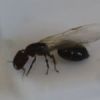Caught around 4pm under a brick with a few larva.
They're grayish/brown in color.
3mm.
Can anyone tell what kind of worker these two ants are? I need to know if they're a Lasius type - and if so, can i use them for a host colony? These are the best pics I can get at the moment.
https://imgur.com/gallery/qqpUe
Edited by Jamiesname, September 17 2017 - 4:37 PM.
















